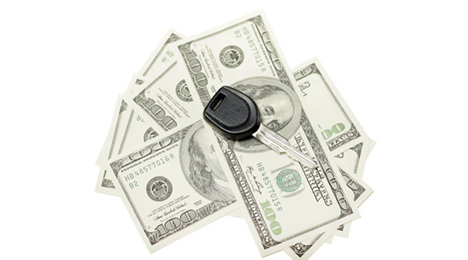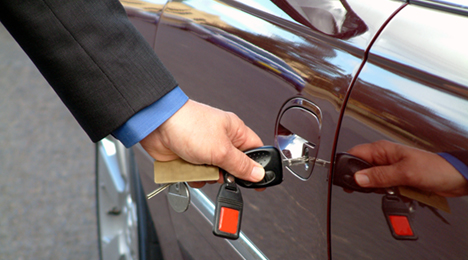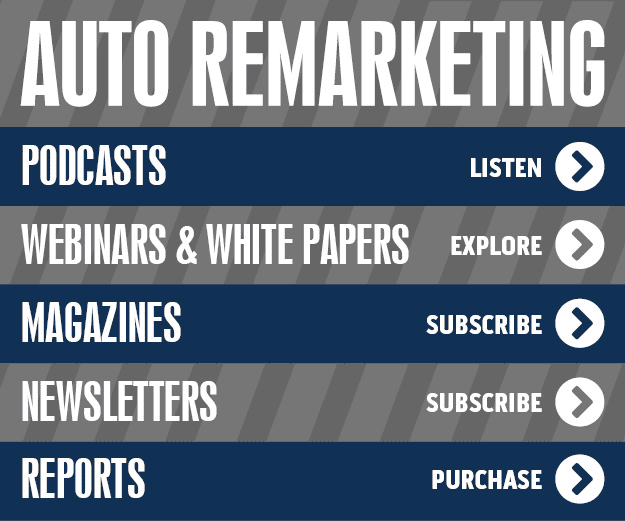Global wholesale floor planning software provider Sword Apak recently announced it will implement its new dealer floor planning and loan solution, WFSv6, with Wells Fargo Dealer Services.
Officials explained the agreement creates a new portal that is designed to address the evolving business needs of Wells Fargo and its dealer customers. They also mentioned the relationship will create an improved experience through simplified system processes, new functionality, business intelligence and greater access to information.
Additionally, the partnership is geared to enable Wells Fargo Dealer Services’ team members to offer even higher levels of client service through expanded service and product offerings.
“Providing effective services and efficient solutions to our dealer clients is at the heart of what we do,” Wells Fargo Dealer Services executive vice president Jerry Bowen said. “Sword Apak’s floor planning solution aligns with our business ethos of customer satisfaction and we look forward to working with them.”
With more than 35 years of experience and a global client base, Sword Apak emphasized that it can deliver enhanced technology-driven solutions and work together with partners to ensure a full understanding of individual requirements with the focus never straying from great customer care.
“We are delighted that Wells Fargo Dealer Services chose to work with Sword Apak to deliver their wholesale floor planning requirements,” Sword Apak sales director James Powell said.
“WFSv6 provides the state-of-the-art technology needed to support a customer-focused business like Wells Fargo Dealer Services, and we look forward to helping them implement their exciting and innovative plans for the future,” Powell added.
GrooveCar Direct — a vehicle buying resource for the nation’s credit union industry — is expanding through new partnerships with a pair of institutions in the Southeast.
Recently coming aboard the program are Insight Credit Union, which is based in Orlando, Fla., and Michoud Credit Union, which operates in New Orleans.
Insight Credit Union is a member-owned financial cooperative with assets of more than $530 million serving 57,200 members since 1991. Located in Orlando, Insight is considered the 25th largest credit union in Florida.
Michoud Credit Union is a member-owned financial cooperative with assets surpassing $4 million, serving 1,106 members. The credit union opened in 1980 with the main office located in New Orleans.
As the economy improves, GrooveCar pointed out that credit unions like Insight and Michoud can take advantage of growth opportunities found in auto financing by providing members with a resource to drive interest and business. Company officials highlighted that since 2012, credit unions have increased their auto business nearly 30 percent, with a 16 percent increase last year.
The GrooveCar program can provide an advantage to credit unions in the market for capturing more vehicle installment contracts from members. The auto buying program can give members with all the resources and interactive functions expected when shopping for a vehicle online.
“The GrooveCar Direct program is the nation’s leading online credit union automotive product. Credit unions are empowered with the ability to grow their auto loan portfolio from within while serving members with the best data, research and value in the auto buying market,” said Robert O’Hara, GrooveCar vice president of strategic alliances.
“For further consideration, our program effectively communicates with the member, an area of interaction credit unions are seeking to fill as in-branch communications are on the decline,” O’Hara continued.
The company also mentioned the process to go “live” with GrooveCar is designed to be seamless with online and phone support as well as a comprehensive training session that takes place under an hour. GrooveCar provides all the necessary tools for a credit union to succeed in marketing the product including customized marketing materials, regular marketing consultations and branding resources.
“Clients comment frequently on how a simple a process it is to partner with GrooveCar,” officials said. “Favorable feedback is repeatedly centered on the live technical support and minimal resources required to get started.
“The comprehensive auto buying resource serves up everything consumers expect to have access to — research and comparison tools, build out features, car values and history reports — all branded to the credit union client and cross promoting the other related products offered,” they went on to say.
Additional information may be found at www.groovecarinc.com/GrooveCar-Direct.
On the heels of the roll-out of a compliance tool, F&I Express recently launched ExpressQuote, a new feature added to the company’s cloud-based solution to help F&I managers provide customers with fast, accurate quotes on aftermarket products.
The company explained ExpressQuote can connect F&I managers to product and price information from a large network of aftermarket insurance product providers. With just the vehicle’s VIN and mileage, F&I managers can access what F&I Express insisted are “100 percent accurate” aftermarket quotes, set a limited time availability on the offer and print a document to give to the customer.
F&I Express management highlighted this process can allow dealerships to engage customers in a conversation about F&I products when they are in a different department. For example, customers might be much more receptive to F&I messages when they are in the service department getting work done on their vehicle.
“F&I Managers need a fast and accurate way to quote customers, even when they aren’t in the F&I office," F&I Express chief executive officer Brian Reed said. “With ExpressQuote, F&I managers can access pricing information from multiple sources in real time.
“Today’s auto shoppers are often time pressed and will want a quick quote from the dealership,” Reed continued. “ExpressQuote helps automotive retailers meet their customers’ expectations.”
Reed added that providing more F&I information to customers earlier in the shopping process can prove to be a significant advantage to automotive retailers in the long run, as better-educated consumers are often easier to close.
“It really comes down to a customer service issue,” Reed said. “Smart automotive retailers realize they need to provide customers with answers — right now. Answering a customer inquiry quickly and efficiently can often make the difference between winning and losing a sale.”
The launch of ExpressQuote arrived not long after F&I Express unveiled a tool to watch margins for compliance.
FactorTrust chief executive officer Greg Rable regularly receives questions from finance companies that are seeking more information about millennials, and for good reason. FactorTrust indicated that millennials — individuals born after 1980 — make up the largest percentage of non-prime auto applicants at 43 percent.
“If you look at millennials overall and their position today within auto, then you fast forward 10 to 15 years,” Rable said, “it will be the segment of their customer base that will be the difference between (finance companies) being successful and not. They want to know as much as possible about them.”
Not only do millennials constitute a larger segment of the potential vehicle installment contract applicants finance companies might see, but they also might have a better capacity to remain current on those deals.
Non-prime auto loan applicants make more money than other underbanked consumer loan applicants, according to FactorTrust’s special auto edition of the Underbanked Index. In fact, millennial non-prime auto applicants have incomes comparable to Baby Boomer consumer loan applicants.
FactorTrust reported non-prime auto applicants make more on average than underbanked consumer loan applicants. Overall, non-prime auto applicants make $3,287 per month, while consumer loan applicants — individuals who used those funds for other personal expenses and purchases — make an average of $2,937 per month.
When SubPrime Auto Finance News recently asked Rable to examine why so many millennials end up being classified as non-prime, he replied, “It could have been something in their past where they may have not managed their credit obligations in a way that allowed them to maintain a prime credit score. But then it’s also market driven.
“As everybody knows over the last five or six years, as the economy has recovered there was a big period of time there between 2008 and to a certain extent even 2011, there were a lot of people right at the prime line or just above the prime who struggled mightily and ended up moving below that prime line,” Rable continued.
“What we’ve seen in the data is a lot of consumers who were historically above the prime line are now below,” he went on to say. “They still have the same needs as everybody else. They still have a need for an auto loan. They’re employed so they need to get to work. They need as many credit options as other people have. They’ve just found that over time maybe the non-prime lenders were the better option for them based on their score at that time.”
And that credit score doesn't just play a role in underwriting; Rable mentioned the consumer stability component, too. FactorTrust’s latest index report showed non-prime auto applicants are more likely to change addresses than consumer loan applicants, while consumer loan applicants are more likely to change phone numbers than auto applicants.
Rable explained that millennials are more open to move from place to place but keep their phone number — likely connected to a mobile device — since “they use it for everything.”
He added that FactorTrust’s 10 years of experience in the alternative data space shows, “consumer stability has been a pretty substantial predictor of credit risk for underbanked and non-prime consumers from the get-go when we started looking at risk. Having all of our customers contribute their data to us allows us to continue to see who that changes over time.”
FactorTrust’s latest analysis also touched on employment.
The company found that most non-prime auto and consumer loan applicants are employed in the retail segment, but employment segments split after that, with the second most-common employment segment for auto applicants being government, and quick-serve restaurants for the consumer loan segment.
The largest employer segment of underbanked millennials is retail, with quick-serve restaurants as the second-largest employer.
FactorTrust brought all of this material to the attention of finance companies because Rable insisted that alternative credit data can enhance their underwriting process. FactorTrust boasts a study that determined a finance company can reduce default rates by up to 48 percent by integrating alternative data into its process.
Rable acknowledged that finance companies changing their protocol from traditional underwriting processes is the hurdle the entire industry has yet to clear when it comes to leveraging alternative data.
“We don’t ever say replace a big three bureau with us. We always say our data augments big three data in the auto space,” Rable said. “It’s really valuable to see everything about this consumer. Today the big three don’t work with a lot of alternative financial services companies. We have a lot of tradelines on these consumers that the big three bureaus don’t have.
“Once lenders understand that aspect and are willing to say that these guys might not have all of the data, once they get over the hump of taking a look at alternative data and understand what it can do for them either by reducing credit risk to helping them fund more loans at scores that maybe they wouldn’t have funded in the past and seeing the value of doing that, the actual implementation in a risk model or whatever their underwriting decision process is can be pretty easy and straightforward,” he went on to say.
FactorTrust also emphasized that the pool of consumers — especially millennials — using alternative financial services likely isn’t going to diminish.
“Based on their age and the time in which they grew up, there is a much larger open view to alternative financial services than older generations,” Rable said. “Those older generations grew up saying you had to have a banking relationship for a checking account and a savings account.
“Younger consumers have a more openness to trying new things and looking at alternative financial services as an opportunity because to a certain extent they like the convenience. They like the speed,” he went on to say. “They recognize that in some cases the products might be priced differently than the more traditional products. But they like what they get in return.”
More key findings outlined in the auto edition of the FactorTrust Underbanked Index can be found by clicking the link below.

The Federal Reserve of New York reported an uptick in consumers who expect to apply for vehicle financing during the next 12 months, but two economists, including Cox Automotive’s Tom Webb, discussed the potential headwinds that might arrive within the employment market as well as consumer confidence.
First, the New York Fed indicated its Survey of Consumer Expectations for June revealed that 12.9 percent of individuals expressed a likelihood of applying for auto financing within the upcoming year. That figure is up from 10.8 percent of individuals who told officials their intentions a year earlier.
However, the survey also showed that 26.5 percent of those consumers believed they likely would be rejected for that financing, up from 23.6 percent recorded in June of last year. What’s interesting is the New York Fed noted that its pool of respondents for the June survey contained more individuals with credit scores of 680 or below (15.8 percent) than the one a year earlier (8.3 percent). Also, consumers with sterling credit (scores of 760 and higher) made up the largest demographic in last year’s survey pool, constituting 14.4 percent a year ago but only 12.2 percent earlier this summer.
Then, Cox Automotive’s Webb revisited a topic he discusses regularly in order to give finance company executives some guidance on how the economy is behaving and how originations might develop.
In the July edition of the Manheim Consulting Auto Industry Brief, Webb acknowledged that a lack of productivity is dimming prospects for wage growth, which, of course, is a key component to vehicle affordability.
In 2014, Webb pointed out that the U.S. economy had a net increase of 3.1 million jobs, a rate that was the fastest pace in 15 years. Webb also mentioned an additional 1.25 million jobs were added in the first half of this year.
“And, of vital importance to the auto lending industry, initial jobless claims (adjusted for employment) are at an all-time low,” Webb said. “Yet, legitimate concerns about the robustness of the labor market remain.”
Although total employment is now 3.5 million higher than the previous peak reached in January 2008, Webb indicated full-time employment is still 822,000 shy of its all-time high.
“This partly explains the weakness in wage growth during the recovery,” he said. “But there is also a more troubling force holding down paychecks — productivity.”
After what Webb described as a “natural bounce back” coming out of the recession, Webb cited federal data that showed annual labor force productivity never exceeded 1 percent between 2011 and 2014.
And in the first quarter of this year, the Bureau of Labor Statistics (BLS) determined productivity was up only 0.3 percent from its year-ago level.
“The drivers of productivity growth are complex,” Webb said. “And, although policies to reverse the secular decline will be difficult to enact and slow-acting, they are the only way to promote real wage growth over the long term.
“Minimum wage laws, overtime pay regulations and guidelines for executive pay are all a sideshow,” Webb continued.
With wages evidently not on a significant upward track, the situation makes the monthly payment component of the vehicle installment contract all the most crucial to the completing of a contract. As Experian Automotive highlighted in the latest State of the Automotive Finance Market report, the average loan term for new and used vehicles originated during the first-quarter increased by one month, reaching new all-time highs of 67 and 62 months, respectively.
Then in an interview with Bloomberg earlier this month, former Santander Consumer USA chief executive officer Thomas Dundon maintained that rising contract terms aren’t necessarily bad for the industry, especially in the subprime space.
“The data would tell you that as long as the payment is affordable and quality of the vehicles is improving, the math says you’d rather give more term so the customer can get a better car,” Dundon told Bloomberg in this report, adding that 72-month contracts may soon be the standard term for prime contracts, too.
Equifax deputy chief economist Dennis Carlson didn’t disagree with Dundon’s thinking, especially when considering the BLS data that Webb referenced.
“The issue is the cost of cars absolutely has gone up. If you look at the price of a new car today versus five or six years ago, it’s certainly gone up faster than wages,” Carlson said.
“I think many people when they purchase a car, whether it’s new or used, they’re really looking at a number they can afford to pay on a monthly basis,” he continued. “If a car costs a certain amount and you’re able to pay X, then your loan is going to require you to reach terms that meet that number. One way we have been seeing that is through the prevalence of longer loans.
“I certainly think that it’s a factor, but I don’t know if it’s the driving factor,” Carlson went on to say. “I certainly would agree that as discretionary income continues to increase, as wages increase, perhaps those longer term loans will be less necessary. I think time will bear out the truth of that statement.”
Whether consumers take out vehicle notes that last 36 months, 72 months or even longer, the confidence in their finances, employment and more likely will impact what kind of financing they take — if any at all.
Stifel, Nicolaus & Co. Fixed Income chief economist Lindsey Piegza recapped the latest report from the Conference Board and Haver Analytics that showed consumer confidence fell from 99.8 to 90.9 in July, the lowest reading since September of last year.
In the details, Piegza noted consumers’ assessment of current conditions fell from 110.3 to 107.4, a three-month low. She added consumers’ expectations, meanwhile, plummeted nearly 13 points from 92.8 to 79.9, the weakest reading in more than a year.
“Consumer confidence was expected to decline slightly at the start of Q3. It was not, however, expected to plunge as it did in the latest report, falling to a multi-quarter low,” Piegza said in her latest economic commentary.
“Consumers are clearly losing confidence in a more robust outlook for the U.S. economy amid growing concerns over stagnant business conditions, fewer jobs and declining income,” she continued. “As consumers lose confidence, they are more likely to tighten their purse strings, further restraining household spending.”
Piegza recapped that June retail sales fell 0.3 percent compared to an anticipated rise of 0.3 percent.
“Coupled with downward revisions to the previous two months, the miss for retail spending in the second quarter totaled a full 1 percent,” she said.
“As a consumer based economy, without the consumer happy and healthy, we have little hope of stability, let alone momentum, as we head further into the second half of the year,” she went on to say.
On Thursday, CrediautoUSA Financial Co. announced the completion of a capital facility that provides for up to $75 million to facilitate the acquisition by Crediauto of non-prime automobile financing contracts.
Crediauto is a finance company that provides solutions to franchised and independent dealers in California. Officials highlighted the facility commitment is supported by capital managed by an award-winning New York-based market leader in alternative lending and specialized credit, with more than $1 billion in discretionary assets.
Rafael Gomez, Crediauto founder and chief executive officer, explained the company can provide dealerships with a competitive choice to finance non-prime buyers, including individuals who might have been turned down by other finance companies.
Gomez mentioned Crediauto has particular expertise in the Latino market. He added that this transaction will enable Crediauto to further increase its footprint in California as an important resource for dealerships.
"Crediauto is excited to use these funds to the greatest positive effect within our community,” Gomez said.
“Our mission drives us every day to make good financing alternatives available to individuals with limited access to credit, and to help them develop their credit history,” he continued. “With this strategic relationship, Crediauto will be able to grow into a recognized leader in the sector.”
Equifax deputy chief economist Dennis Carlson used imagery of the plumbing that might be in your home to describe the industry surpassing $1 trillion in outstanding auto loan balances in June.
The credit bureau’s data showed total outstanding balances on vehicle installment contracts and leases increased 10.5 percent year-over-year to come in at $1.021 trillion last month. Equifax also reported the number of outstanding accounts rose 8.0 percent from a year ago to 73.7 million.
During phone interview when Equifax shared this data exclusively with SubPrime Auto Finance News, Carlson explained, “Essentially if you think of the total dollar value of loans outstanding, it’s like a bathtub and there’s a spigot and a drain. Right now, the spigot is filling the tub faster than the drain of people paying off their car.
“It speaks to the consumer pent-up demand and appetite for new-to-them automobiles,” he continued when elaborating about what eclipsing the $1 trillion mark means to the industry. “Obviously we’ve seen pretty strong new-car sales numbers, but the new-car sales don’t tell the whole story. Certainly used cars are being financed as well.
“It shows a lot of consumers feel they’re in a position to replace their older cars with a car that’s new to them,” Carlson added.
The flow from that spigot Carlson mentioned certainly hasn’t slowed, according to the origination information Equifax made available that recorded activity through April.
During the first four months of 2015, Equifax indicated more than 9 million auto loans filled portfolios, totaling $182.9 billion. These figures represented a 5.8-percent increase in the number of accounts and an 8.0-percent rise in balances compared to a year earlier.
Analysts also pointed out the figures marked the highest levels for the period since Equifax began tracking this data.
Overall, Equifax determined finance companies are growing originations more quickly than commercial banks with 54.2 percent of all new auto accounts and 51.8 percent of dollar originations through April were booked by finance companies.
The upward trends are notable in the subprime space, too.
Analysts reported 2.12 million auto loans were originated through April to consumers with an Equifax Risk Score below 620, what this credit bureau generally considers subprime accounts. The figure marked a 9.6-percent increase year-over-year. These newly issued contracts have a corresponding total balance of $37.2 billion, an 11.7 percent increase year-over-year.
Also noteworthy, Equifax mentioned that through April, 23.5 percent of auto loans were issued to consumers with a subprime credit score.
The average amount for all auto loans generated in April was $20,800, signifying a 3.65-percent increase year-over-year. Also according to Equifax, the average subprime loan amount booked in April came in at $18,200, a 3.74-percent rise year-over-year.
Editor’s note: Watch for a report coming in Friday’s edition of SubPrime News Update containing Carlson’s analysis of Equifax’s data regarding delinquency and write-offs.
Vero Products — a provider of in vehicle after-market solutions and services and a division of CU Direct — acquired Fidelis PPM this week to form a new company focused on pre-paid maintenance (PPM).
As a result of the acquisition, officials highlighted that Vero and Fidelis PPM formed DRIV Technologies to provide the dealers with what they described as a dynamic pre-paid maintenance (PPM) technology platform to advance customer retention and boost loyalty.
DRIV Technologies’ PPM solution is being used by 1,000 dealers and is the private label solution for multiple F&I administration and insurance companies nationwide.
Vero is a provider of finance, insurance, anti-theft and customer and loyalty retention products and services to franchise and independent dealerships throughout the U.S. Vero’s parent company, CU Direct, serves 12,000 dealerships, providing automotive solutions, including the CUDL auto lending network of more than 1,000 credit unions.
“DRIV is set up to scale on a national level and become a tremendous complement to existing offerings, including Vero’s full suite of F&I products, and CU Direct’s CUDL products,” said Ryan Williams, president of DRIV Technologies.
“With our existing TPA, retail and OEM relationships we look forward to extending our reach, while continuing to help our dealers achieve world class customer retention results through a sound pre-paid maintenance strategy,” Williams continued.
With certified integration partners such as CDK, Reynolds and Reynolds RCI, F&I Express, ODE/PEN and e-menu providers, officials also pointed out DRIV is able offer up a unique and seamless retention solution with its private label partners, achieving better than a 65 percent service retention rate for its dealer clients.
“Service drive revenue is set to reach a record $215 billion in 2015, and it is important for dealerships to incorporate programs that help capture that market, while building customer loyalty and retention,” Vero chief executive officer Joe Annoreno said.
“Leveraging DRIV Technologies’ solutions and expertise gives Vero an extensive, unmatched line-up of aftermarket solutions to help dealers advance customer relationships and grow their bottom lines,” Annoreno added.
To learn more about DRIV Technologies and Vero’s suite of aftermarket solutions, visit www.getfidelis.com and www.veroproducts.com.
According to a national survey commissioned by Carvana, consumers still are uninformed about the total costs associated with the interest rate connected to their vehicle installment contract.
Carvana — a completely online vehicle retailer backed by DriveTime and launched two years ago — found that 71 percent of consumers who have ever taken out an auto loan are not aware of the total dollar amount of interest spent on their last loan.
The survey also revealed 69 percent of individuals included in the research do not understand what a 1 percentage point reduction in their rate would save them.
The survey was conducted online from April 9-13 on Carvana's behalf by Harris Poll of more than 2,000 U.S. adults. A closer look at the results indicated that among those who have ever taken out an auto loan, knowledge of the total amount paid on their last loan, or the potential for savings, varies slightly across age, gender and income levels.
However, the majority of these consumers are still in the dark when it comes to the importance of shopping around for the lowest possible rate. A few examples:
• 68 percent of those with a college degree or higher do not know the total amount of interest they will owe/owed on their most recent auto loan.
• Amongst those households earning less than $50,000 a year, 77 percent are also in the dark on the total cost of their loan.
• 81 percent of millennial females (ages 18-34) could not answer how much money they could have saved if they were able to reduce their current/previous auto loan interest rate by one percentage point.
"It is clear that car buyers have a lack of understanding surrounding interest rates. We are solving that by bringing transparency to another step in the car buying process. Whether a consumer is purchasing a vehicle from Carvana or through another channel, we want them to feel confident they are getting the best possible deal available,” Carvana founder and chief executive officer Ernie Garcia said.
“Interest rates can add thousands of dollars to the final price of a car, and every percentage point matters,” Garcia continued.
To enhance its services in light of the survey results, Carvana introduced what it has dubbed its Fair Compare Interest Rate tool.
The latest product from Carvana can allow consumers to determine the average interest rate they should pay for a loan based on their personal credit score, the vehicle price and the state in which they live. The tool’s data is driven by Experian and is derived from millions of actual consumer interest rates for loans.
In addition to informing consumers on a fair interest rate, Garcia noted the product also can compare it to the average interest rate available from Carvana. This comparison is designed to enable users to see how different interest rates directly affect both the monthly payment and overall dollar savings over the life of the vehicle installment contract.
“This new tool shows users one-on-one comparisons of which financing source can offer the best rate as well as the total savings, even if the Carvana rate isn't the lowest option available,” Garcia said.
Similar to the company's vehicle price comparison tool, which compares Carvana’s prices to the Kelley Blue Book Suggested Retail Price, the new Fair Compare interest rate product leverages technology to put information and full control “back into the consumer’s hands.”
For more information and to access Carvana's Fair Compare Interest Rate tool, visit www.Carvana.com/rates.
Michael Buckingham, senior director of the auto finance practice at J.D. Power, acknowledged dealers and finance companies already know that trying to get a new-vehicle contract completed for a customers with a soft credit profile can be “tricky.”
So when J.D. Power released its 2015 U.S. Dealer Financing Satisfaction Study on Monday, Buckingham mentioned two points that helped finance companies that book non-prime paper to score higher marks.
Buckingham shared with SubPrime Auto Finance News that the first component is important no matter if it’s a deal for someone with sterling credit or if the individuals just had a bankruptcy discharged. That’s speed of funding and completion of the application process.
“It makes sense because you’ve got trickier credits. It’s not like just checking the box and saying no problems,” Buckingham said.
“There are so many more multiple franchises managed by general managers and principals,” he continued. “As these dealers are getting bigger, they’re sitting back and saying, ‘Cash flow is king for us. Let’s not hold out for a little bit of rate or a little bit lower lender fee or things like that.’ They’re looking at cash flow.”
Buckingham noted that study results showed the application process also can be improved when stipulations for funding are clearly known by store finance managers.
“It is really critical for the lender through their sales team to help the dealer understand exactly what their parameters are,” he said. “We see that really resonate where the lender has got to do a great job of making sure of what they’re looking for and what’s in the buy box is clearly articulated out there.
“We see a huge sway when that’s not being done. You can think about it and it’s just causing a lot of frustration and to a degree time wasters,” Buckingham added.
The other element that helped finance companies that cater to the non-prime space to score higher in J.D. Power’s study was improvements in the verification. For example, Buckingham mentioned that finance companies that have alliances with credit bureaus to validate residency or income made dealers more satisfied.
“They’re looking to see a lender that’s easy to work with. If they’re seeing a lender eliminate some of the stips, there’s definitely higher satisfaction,” Buckingham said.
Overall study results
In the highly competitive auto financing environment, J.D. Power determined the level of service provided, including technology and a collaborative and consultative staff, is more important than price, as dealers are willing to pay a premium for high-quality service.
The U.S. Dealer Financing Satisfaction Study measures dealer satisfaction with finance providers in four segments: prime retail credit; non-prime retail credit; retail leasing; and floor planning. Satisfaction is calculated on a 1,000-point scale.
Dealer satisfaction in the prime retail credit segment came in with an average score of 868. In the non-prime retail credit segment, satisfaction settled at 828.
Dealer satisfaction in the retail leasing segment stood at 894, while in the floor planning segment, satisfaction topped out at 943.
While dealerships continue to seek ways to improve their margins, Buckingham reiterated that they also seek providers to speed customer throughput in the sale or lease of their vehicles and in many instances are willing to pay a premium for a higher-quality financing experience. He noted 63 percent of dealers are willing to pay an additional 0.50-0.60 basis points on their loan terms (down 4 percentage points from 2014) to receive good service from their lenders in the prime retail credit segment.
J.D. Power acknowledged that the industry works hard to establish high-value, one-on-one relationships with customers when it comes to the sales and service processes. The same principle applies to dealers when it comes to the relationship with their finance companies in all consumer-facing products — prime retail credit, non-prime retail credit and retail leasing.
“Auto lending continues to be a relationship business. Findings of the study show that assigning/aligning dedicated underwriters positively impacts dealer satisfaction by providing higher levels of service and collaboration,” J.D. Power said.
As Buckingham pointed out, the study showed a dealer-focused sales rep relationship has a positive effect on satisfaction and retail contract volume.
When a high level of sales rep service is provided, satisfaction is substantially higher than when there is no focused support (935 versus 754, respectively). Among dealers with a focused relationship in which all sales rep relationship key performance indicators (KPIs) are met, 68 percent said they “definitely will” increase the percentage of business they conduct with their provider.
“Speed of funding has become a critical differentiator in the eyes of the dealer as efficient cash flow is demanded by dealer management, not absolute finance and insurance income,” Buckingham said.
“Fast application processing allowing dealers to speed the customer delivery process is also critical. Auto dealers are willing to pay a price premium for these services,” he went on to say.
Buckingham added dealers don’t want loan processors, instead, stores want collaborative consultants who can support them every step of the way.
“High-performing lenders provide a range of services that resonates with dealers, which include helping them understand the variety of lending options available and how they can maximize profits, reduce expenses and retain customers,” J.D. Power said.
Other key findings
J.D. Power mentioned six other notable points stemming from this year’s study, including
— A majority (84 percent) of dealers indicate their lender provides a dedicated underwriter person and or team who contacts them frequently, providing valued-added communications.
— Overall satisfaction is highest when sales reps engage in discussions about customer retention (922), dealership performance consulting (916) and training and clarification of programs (916), compared with when they do not (831, 818 and 816, respectively).
— In the floor planning segment, 85 percent of dealers are assigned a primary support representative or team who can quickly respond to their needs and questions. Additionally, 75 percent of dealers indicate being able to immediately reach their support staff. When this occurs, satisfaction is 975. When dealers have to wait one hour to reach their support staff, satisfaction declines significantly to 938.
— eContracting, or finance company-provided technology that enables same-day contract funding, improves dealer satisfaction. When dealers use eContracting or a proprietary technology provided by their lender, overall satisfaction averages 913, compared with 856 when lenders do not use this service. Additionally, 56 percent of dealers indicate that faster funding time is the main reason to use eContracting. On average, there is a 39 percent increase in dealers’ business with their finance provider due to eContracting.
— The study found that dealerships retain 59 percent of their leasing customers through retention programs and consumer guidance provided by their lender.
— A total 75 percent of dealers indicate increasing retail business with their provider because of their floor planning relationship.
Dealer financing satisfaction rankings
Mercedes-Benz Financial Services ranked highest among finance companies in the prime retail credit segment with a score of 971. Following in the rankings were Mini Financial Services (962) and Alphera Financial Services (961).
Mercedes-Benz Financial Services also took the highest mark among finance companies in the retail leasing segment with a score of 978. Following in the rankings were BMW Financial Services (961) and Lincoln Automotive Financial Services (956).
Furthermore, Mercedes-Benz Financial Services ranked highest among floor planning providers for a fifth consecutive year with a score of 986. Following in the rankings were BMW Financial Services (974) and Ford Credit (961).
Satisfaction is measured across three factors in the prime and non-prime retail credit segments, including:
— Finance provider offerings
— Application and approval process
— Sales representative relationship.
Four factors are measured in the retail leasing segment, including:
— Finance provider offerings
— Application and approval process
— Sales representative relationship
— Vehicle return process.
Four factors are measured in the floor planning segment, including
— Finance provider credit line
— Floor plan support
— Sales representative relationship
— Floor plan portfolio management.
The study captures nearly 21,798 finance provider evaluations across the four segments. These evaluations were provided by roughly 3,934 franchised dealerships in the United States.













